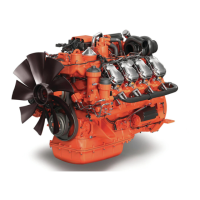OPM 300 en-GB 103
© Scania CV AB 2020, Sweden
Reductant for SCR
Reductant for SCR
The operator is responsible for using the correct
type of reductant to ensure that local laws are
complied with.
In order for the emission control to meet the
emission requirements set by the public authori-
ties, the reductant should be specified in accord-
ance with ISO 22241.
Reductant is a solution consisting of urea and
water, and is usually called AdBlue®, DEF,
ARLA 32 eller AUS 32depending on the mar-
ket. If the engine is equipped with an SCR sys-
tem, the reductant is added to the exhaust gases
upstream of the catalytic converter. This reduces
nitrogen oxide emissions.
Reductant in accordance with ISO 22241 con-
tains 32.5% by weight of urea and freezes at ap-
proximately -11°C (12°F). When the solution
freezes, ice and urea always maintain the same
concentration. Always store reductant at a tem-
perature between -11°C and 30°C (12-86°F).
Rec. % by weight of
urea
Limit values according
to ISO 22241
32.5% 31.8-33.2%
Reductant is normally colourless if no dye has
been added. It is not harmful to the skin. Nor is it
toxic in small quantities, but it tastes very un-
pleasant.
Reductant is highly corrosive. Therefore, rinse
any reductant spillage from connections and oth-
er details using lukewarm water. Water works
very well for cleaning purposes. Please use hot
water. If reductant seeps into electrical connec-
tions or electrical cables, these must be renewed.
Reductant has a low surface tension and rapidly
spreads over large areas, which then become
very slippery.
Reductant can dry out and form white or greyish
brown crystals or deposits that can be washed
away with warm water.
The risk of crystal formation increases with low
outdoor temperatures. When the outdoor temper-
ature is below -20°C (-4°F), reductant dosing is
switched off to avoid the risk of crystals forming
in the SCR system.

